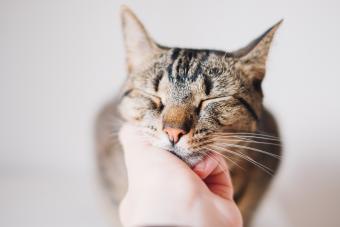
When dealing with problem behaviors from your cat, it can be frustrating attempting to communicate with another species to let them know you're unhappy. Unfortunately, how you do this can have negative consequences on the cat's future behavior and relationship with you. Using positive reinforcement and understanding why a cat does the things it does is the key to a happy feline household.
Principles of Cat and Animal Behavior
It helps when dealing with any undesirable behavior to understand how cats learn. These principles of learning and behavior are the same for all animals, including humans! Basically, the more you reinforce a behavior, the more you will get that behavior. Likewise, the less successful a behavior is, the less likely an animal will repeat it. So the key with training any animal to stop doing a behavior is train them to do what you want instead. It is far easier for the animal to understand "do more of this and good things will happen" than to "not" do a behavior without any alternative offered.
Why Punishment Is Counterproductive With Cats
While you will no doubt read all over the Internet about using punishments like squirt bottles to stop a cat from doing something, this is actually not a good idea. There are several reasons:
- Squirting a cat with a water bottle does not tell the cat what you want them to do instead, so while they may stop the behavior you don't like, they can easily go on to do something else you don't like.
- Your cat may become scared of you and while you may think it's only water, and it's not painful, you're not appreciating the cat's perspective on a sudden unpleasant spray of something onto them.
- Your cat may begin to associate the unpleasant stimulus of the water spray with you, which can damage your relationship with your cat.
- The cat associating the punishment with you can also lead to the cat not doing the behavior when you're in the room and holding the spray bottle, but continuing to do it if you're not holding the spray bottle or if you're not around.
- Finally, some cats don't care at all about water and actually like it. In which case, your method of scaring them off a behavior will do nothing and now you have a wet cat shredding your house plants or your furniture and ignoring you.

Work With Your Cat to Correct Problems
For many types of unwanted behaviors, the most effective and kindest way to stop a cat from doing something you don't want is to follow these five steps.
Step 1: Why Is the Cat Behaving This Way?
Understand what the motivation behind the behavior is. Note that it's very important to understand the motivation of the cat as a species rather than using anthropomorphism, which is the assigning of human motivations and emotions to an animal.
Step 2: What Do I Want?
Determine the behavior you'd prefer your cat to be doing instead. For example, if your cat is jumping on the counter, you can decide you want them to have all four paws on the kitchen floor. Katenna Jones, an Associate Applied Animal Behaviorist who works with cats says she, "Tells clients to look for the glass half full" in the scenario.
Step 3: Prevention and Redirection
Set up your environment so that your cat can't do the undesirable behavior and has access to more enticing options which encourages him to do the alternate behaviors. Jones gives the example of a cat that eats houseplants. Put the plants out of reach and put some edible cat grass or plants there so he can nibble on them and satisfy his natural urges.
Step 4: Communicate With Training
Reinforce your cat for the behavior you want to help his kitty mind understand what you want from him. If he gets things that he enjoys when he does the things you want, this helps him want to do them more.
Step 5: Professional Assistance
If your cat's problems are more complicated or serious or if there could be a possible medical issue, do not hesitate to reach out to a veterinary or behavior professional for help. Likewise if you've tried these steps and are not seeing improvement, a professional can give you some pointers on things you might have missed. You may not need this step in every situation but in ones where you do, asking for help can be a real solution to a problem that results in a better life for you and your cat.
Dealing With Cat Biting
Using the five-step method, look at your cat's biting behavior and understand why he's doing it.
- If he's biting you during play or petting, it could be that he didn't learn proper bite inhibition as a kitten, or he is a kitten and he's not aware yet that he's hurting you. It may also be because he has been inadvertently reinforced for play biting and now he understandably thinks this is what he is supposed to be doing. Note that for extreme aggression working with a behavior professional is strongly advised in order to keep everyone safe.
- Once you've figured out the why, decide what you want instead. In the case of play biting, this could be playing with you without biting your hands or biting toys instead of your hands.
- Prevent the behavior from not engaging in any play that involves biting. If he jumps on your lap and starts chewing on you, just get up and walk away. You don't need to make noises or yell or do anything else as the "punishment" because this is actually giving attention to the cat. Instead, in this scenario the loss of your company and attention is less desirable and more likely to be effective.
- Redirect the behavior by providing toys that you can play with that won't lead to him biting you. Fishing-wand type toys are perfect for this, as well as small balls you can toss.
- Once you've found an acceptable activity, use training to let him know this is a good thing to do. When you pull out a wand toy to play, you're reinforcing to him that this type of play gets him what he wants, which is fun and exercise. When kitty is not biting you, praise, pet, play, or even give treats to show him this is a better choice. Or if you're feeling really ambitious, pull out a clicker and some treats and teach him to bring that ball you tossed back to him for a game of fetch!

Dealing With Scratching Furniture and Household Items
Anyone who owns a cat knows about the scratching which can cause havoc on your belongings.
- The "why" behind cat scratching is that this is a natural behavior for them. It helps them keep their claws sharp and provides some physical exercise, as well as a mental outlet for something to do to pass the time. It also is a form of scent marking.
- An alternative that would be great for any cat owner is for your cat to scratch something that's made for scratching, like a scratching post. Jones recommends that you choose a post that, "has a texture and angle and location similar to what the cat has chosen to scratch. For example if the cat is scratching horizontally on the carpet in the living room and you provide a vertical cardboard scratcher in the guest room, it will never work! Get a horizontal carpet covered scratch post and put it right over the area you don't want the cat to scratch."
- Prevention can include providing repellents to keep your cat away from places like your couch or house plants. Ideally you only want these in place temporarily while you reinforce your cat for using the acceptable scratching places. Another form of prevention could be putting Soft Paws on your cat's nails to keep them from damaging the furniture without hurting them. Trimming your cat's nails regularly can also reduce scratching.
- The behavior is redirected by providing your cat with plenty of excellent options such as multiple scratching posts and cat trees with scratching areas. Some cats even enjoy having these areas rubbed with catnip to make them more exciting, although it can make some cats aggressive while others ignore the scent entirely.
- You train your cat by picking him up anytime he goes near the undesirable places and bringing him to the acceptable places. Do this quietly without emotion and then once you get to the scratching posts or cat trees, have a cat party! Give him some kitty treats, brush him, play with him on and around them with cat toys and do whatever he really loves so he learns these are the places to be.

Dealing With Cat Fighting
If you have two cats that fight, this is an issue that most likely would benefit from professional assistance. However you can still use the five-step process to understand more about what's going on and put some prevention in place.
- Cats can fight with each other for a number of reasons so you'll have to look at your cats and their histories to figure out the cause. It could be related to fear and anxiety, territoriality, or sexual behavior and competition.
- In the case of fighting cats the most common desirable behavior would be a harmonious household where the cats may not love each other but don't engage in physical fights.
- Prevention is very important in these cases to make sure no one, including yourself, gets hurt. This can mean keeping the cats confined to certain areas of the household where they cannot get to each other. It can also mean providing lots of high spaces for cats to go to if they feel harassed, such as window perches and cat trees.
- Redirection will involve providing alternate things for your cats to do instead of fighting. Usually in cat fights one cat is the aggressor so this is the cat that you want to provide lots of exercise through toys and training. The cat that is on the defense should receive enrichment as well to help him feel safer and more relaxed.
- Training for cats that are fighting involves a behavioral modification plan where you will need to reintroduce them slowly to each other using reinforcement to build up a positive association between each cat. Jones strongly recommends seeking out a behavior professional well versed in cat behavior as, "handling aggression on your own will likely make it worse."
Dealing With Cat Behavior Problems
There are many other common problems that cats can engage in that humans find unpleasant. This can include not using the litter box, excessive vocalization and urine spraying. With all of these problems, break them down using the five steps and working to understand the species-specific basis for the behavior and finding something more acceptable to you to reinforce your cat to do. It's important to know with any pet behavior problem that they are not doing it out of spite or anger or any other complex emotions but because there is something inherent in their behavior that causes them to need to do it. If you can find out what that is and provide them with a better outlet, you can solve the problem without causing more stress on the cat. Knowing what your cat needs and how to provide it in a healthy, appropriate way is a sure sign of loving them!







